Author details:
1 School of Agriculture and Food Sciences, The University of Queensland, Brisbane, QLD, Australia; 2 Instituto de Tecnología Agropecuaria (INTA), Leales, Tucumán, Argentina; 3 Centro para la Investigación en Sistemas Sostenibles de Producción Agropecuaria (CIPAV), Cali, Colombia; 4 Instituto de Ciencia Animal (ICA), La Habana, Cuba; 5 Formerly: Universidad de Los Andes, Facultad de Ciencias Forestales y Ambientales, Mérida, Venezuela; 6 Universidade Federal de São João del-Rei (UFSJ), São João del Rei, MG, Brazil; 7 Universidad Autónoma de Yucatán, Mérida, Mexico.
Abstract
Leucaena leucocephala (leucaena) is native to Mexico and Central America and is currently naturalized in the majority of Latin American countries. Over the last 2 decades, considerable research and promotion of leucaena have been carried out in Colombia, Mexico, Cuba, Brazil, Paraguay and Argentina. Research focused on the agronomic and management options for feeding beef, dairy or dual-purpose animals, with some studies on germplasm, weediness issues, toxicity, organic fertilizer application and environmental services.
Over the past 10-15 years, establishment and management of leucaena feeding systems in Latin America have varied according to country. For instance, intensive Silvopastoral Systems (iSPS) models are widely promoted and successfully adopted in Colombia, Mexico, Cuba, Venezuela and Northeast Brazil. In iSPS, leucaena is planted at high density (>10,000 trees/ha), in combination with improved tropical grass and high-value timber species (200-400 trees/ha), and intensively managed employing rotational grazing.
In Paraguay and Argentina, leucaena is planted in single or double hedgerows with inter-row alleys of 6-8 m, following the configuration used in Australia and mainly focused on beef production. In Mexico, leucaena is also cultivated with Tithonia diversifolia or lemon trees. Meanwhile, in other countries such as Cuba, leucaena has been established as protein banks using single/twin rows with inter-row spacing of 2-4 m for feeding beef, dairy or dual-purpose animals. Overall, paddock sizes for protein banks and iSPS range between 0.3 and 50 ha, while single and twin hedgerow systems are generally established over larger areas (20-500 ha). Despite the significant benefits demonstrated by research on leucaena feeding systems over the past 2 decades, coupled with successful outcomes for farmers who have adopted these systems, total area sown remains low across Latin America. This review provides a comparison between Latin American and Australian leucaena pasture systems, and recommendations for future collaborative research between countries.
Keywords: Adoption, beef production, dairy production, high-quality forage, tree legumes
Introduction
Leucaena leucocephala (leucaena) is a native multipurpose tree legume from Mexico and Central America and is currently naturalized in the majority of Latin American countries. Its use varies widely from human food, fuel, timber and shade (for perennial crops and livestock) to fodder for ruminant animals. According to Parrotta (1992), this species can be found in a range of environmental conditions across latitudes between 30° N and 30° S. It grows well in areas that receive annual rainfall of 500- 2,000 mm, with dry seasons of 2-3 months, and with well-drained soils that are slightly acid (pH 6) to moderately alkaline (pH 7.5). Optimal temperatures range between 20 and 30 °C, but its growth is restricted at low temperatures (<15 °C), although it can survive mild frost events.
The aim of this review is to provide an update of research carried out with leucaena in the last 18 years (2000-2018) in Latin America and describe its establishment and management for ruminant feeding by region. Finally, it will provide a comparison between leucaena feeding systems in Latin America and Australia.
Research in Latin America
In the past 2 decades, Latin American researchers have actively participated in various leucaena studies involving germplasm, weediness issues, toxicity, animal production, organic fertilizer application and environmental services. To estimate the level of research activities on this species, Scopus, the worldwide largest abstracting service and database of peer-reviewed research literature (scientific journals and books plus congress and conference proceedings), was used to count the number of leucaena publications (where leucaena was included in the title or keywords) carried out by Latin American institutions. From 441 papers published between 2000 and 2018, 95% involved researchers affiliated with institutions from Brazil (117), Mexico (111), Cuba (89), Venezuela (44), Colombia (40) and Argentina (14) (Figure 1). Although it may not take into account all research published in congress and conference proceedings, it provides a snapshot of the status of leucaena research in Central and South American countries (Figure 1, Table 1).

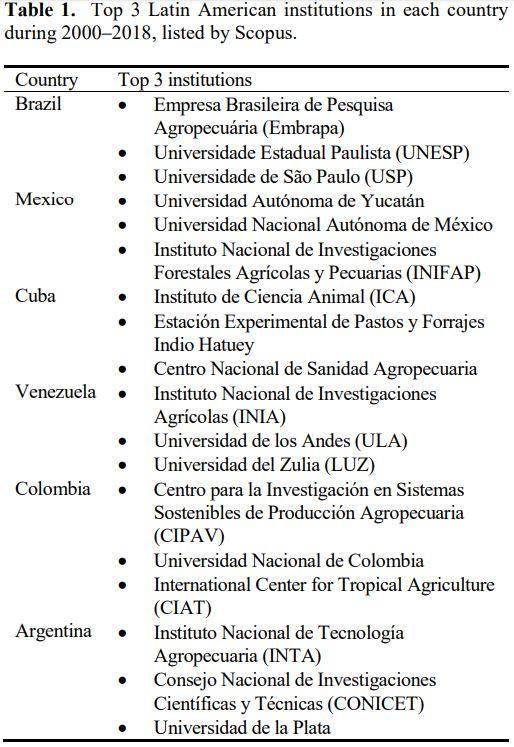
Establishment and management of leucaena by region
Leucaena grows well and is adapted to a wide variety of environments in Central and South America (Lascano et al. 1995). However, its establishment and management vary by region. In this review, we have identified and characterized 3 different systems for growing and utilizing leucaena:
- Protein bank systems: mainly found in Cuba and Venezuela;
- Intensive Silvopastoral Systems (iSPS): found in Colombia (Caribbean region, Inter-Andean valleys); Mexico (Michoacán, San Luis de Potosí - Huasteca region, Veracruz, Tamaulipas, Yucatán, Campeche, Jalisco, Guerrero and Colima states); Panama (Azuero province); Cuba; Venezuela (Llanos); Brazil (state of Maranhão); and Argentina (Misiones province); and
- Australian-style systems: found in Paraguay (Chaco) and Argentina (Chaco, Formosa and Corrientes provinces).
A brief description of each production system is as follows:
Protein bank systems
In this system, leucaena is established strategically in small areas of the farm with the aim of providing a high-level protein source for cattle. Typically, site preparation is carried out by strip or total cultivation of the paddock using animal draft power and to a lesser extent, if farmers have access to tractors, mechanical cultivation. Inoculation of seeds with specific Rhizobium strains, such as ICA 4006 and ICA 4010 developed by the Institute of Animal Science (ICA, Cuba), is recommended. Fertilizer application is not a common practice owing to its high cost and labor requirement; however, the use of animal manure is highly recommended in soils that have been previously used for cropping. According to Ruiz et al. (1989), the optimal time for establishing leucaena is during the rainy season (April-June), particularly for cvv. Peru and Cunningham. Planting configuration of leucaena is usually in single or twin rows (2-5 plants/m), with 3-4 m inter-row spacing, providing densities between 5,000 and 8,000 shrubs/ha. Chemical or mechanical weed control is critical during the first 2-3 months after planting. Leucaena is intercropped with grasses such as Cynodon nlemfuensis and Megathyrsus maximus once the leucaena seedlings reach 0.1 m height. However, first grazing or cutting is not recommended until leucaena plants reach 1.2–1.5 m height. The main use of the protein bank is for feeding dairy and beef cattle in cut-and-carry systems or for grazing with limited temporal access.
Intensive Silvopastoral Systems (iSPS)
ISPS were developed in Colombia by CIPAV (Centro para la Investigación en Sistemas Sostenibles de Producción Agropecuaria). In these systems, leucaena is planted at high density (>10,000 shrubs/ha) in combination with improved grasses, including native or exotic trees and palms (200-400 trees/ha). The establishment, management and benefits of iSPS have been described and reported (Murgueitio and Ibrahim 2008; Uribe et al. 2011; Murgueitio et al. 2011, 2016; Zapata Cadavid and Tapasco 2016). Briefly, land preparation is carried out by mechanical cultivation and the needs for fertilizer application or soil amendment are assessed according to soil analysis. Common leucaena cultivar used is Cunningham. Before planting, seeds are scarified and inoculated with specific Rhizobium at 0.5 kg bacterial culture/10 kg seeds. Recommended planting configuration is single rows with 1.5-1.6 m between rows and 0.3-0.4 m between plants within rows, which provides leucaena densities of 10,000-22,000 shrubs/ha. Improved grasses such as Megathyrsus maximus and Cynodon plectostachyus are sown at the same time as leucaena or about 45 days after planting, when the legume has established. Overall, the firstgrazing is carried out 3-6 months after planting leucaena using a low stocking rate, followed by a pruning of leucaena at 0.5-0.75 m for stimulating growth of branches. Leucaenagrass pasture is managed using intensive rotational grazing (12-48 hours) with electric fences and permanent supply of water, followed by 40-45 days for pasture recovery. The main use of iSPS is for feeding beef cattle, dual-purpose cattle and cows on tropical dairy farms (Figures 2 and 3). It is important to mention that leucaena toxicity is not considered as a limitation; therefore animal inoculation with the rumen bacterium Synergistes jonesii is not a common practice.
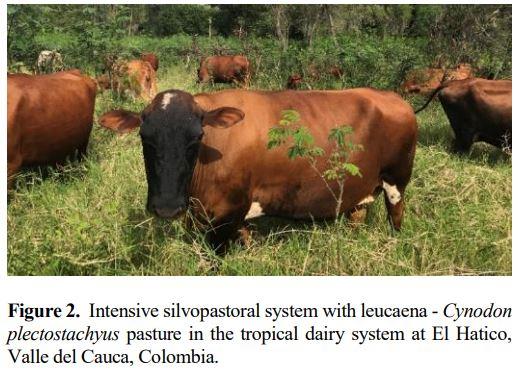
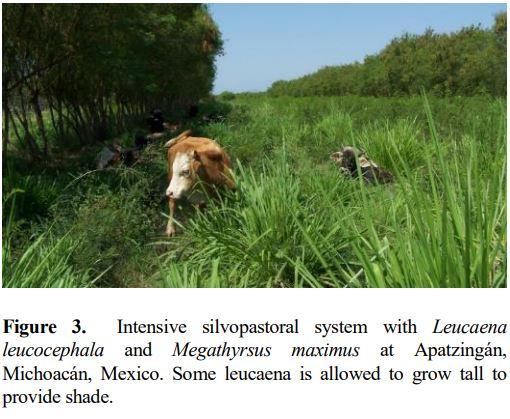
Adopted Australian-style systems
In these systems, adopted and adapted by Paraguayan and Argentinian farmers, leucaena-grass pastures are established following procedures similar to those recommended in Australia (Dalzell et al. 2006; Radrizzani et al. 2019). Briefly, land is prepared by repeated mechanical cultivation and seed is scarified and inoculated with specific Rhizobium cultures. Common cultivars used are Cunningham, Tarramba and Peru. Recommended configuration is single or twin rows (1 m apart) with inter-row alleys between 5 and 6 m. After planting, weeds are controlled by chemical or mechanical means and, to a lesser extent, using manual weeding. In Argentina and Paraguay, intercropping with maize, soybean or sorghum is practiced after planting leucaena with the aim of controlling weeds and making use of the inter-row alleys. Grasses are introduced when leucaena reaches 1 m height (Figure 4). The common companion grasses are Megathyrsus maximus, Chloris gayana and Urochloa brizantha (cvv. Marandu, Xaraés and Mulato II). Leucaena is grazed initially when it reaches 2- 2.5 m height. After that, the pasture is managed using rotational grazing mainly by beef cattle. Paraguayan producers inoculate their animals with rumen fluid, considered to contain the bacterium Synergistes jonesii, but this practice is not carried out in Argentina due to unavailability of inoculum. Still, the occurrence and effect of toxicity on animal productivity are unclear. Radrizzani and Nazca (2014) reported animal toxicity symptoms in an experiment with high proportion of leucaena in available feed (40%) in beef cattle in the Chaco region, Argentina. However, in several other experiments animals showed no symptoms (Gándara et al. 1986; Lacorte et al. 1987; Gándara and Casco 1993; Lacorte 2001; Pachas et al. 2012).
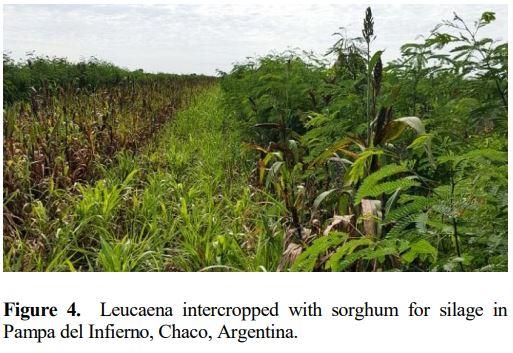
Comparison between the Latin American and Australian leucaena feeding systems
Leucaena pasture systems used in Latin America and Australia have similarities and differences, which are summarized in Table 2. Regardless of differences, e.g. planting density and establishment, both systems are highly productive, profitable and sustainable (Klassen 2005; Dalzell et al. 2006; Murgueitio et al. 2011; Calle et al. 2013; Pachas et al. 2018).
An important difference between the regions is that leucaena is an important component in the diet of dairy cattle in South and Central America but is used only to feed beef cattle in Australia. Another difference between regions is the area cultivated. The area of leucaena in Latin America is not well defined but it is most likely to be between 45,000 and 55,000 ha. The area established in Cuba is approximately 20,000 ha, ~7,000 ha as protein banks and the remaining 13,000 ha in association with grasses (T. Ruiz unpublished data). There are approximately 12,000 ha in 10 states of Mexico (Ramírez-Avilés et al. 2019), ~10,000 ha in Paraguay (Glatzle et al. 2019), with 3,000-5,000 ha in Venezuela (E. Escalante unpublished data), ~2,400 ha in Argentina (Radrizzani et al. 2019), 3,000 ha in Colombia (F. Uribe unpublished data) and perhaps 1,000-1,500 ha in the remainder of Latin American countries. This figure is significantly lower than ~200,000 ha cultivated in Australia. However, due to leucaena being planted in small areas (1- 50 ha), the number of smallholders who have adopted this system is relatively higher (estimated at ~6,000-8,000 producers) compared with Australia (estimated at 500-1,000 producers).
Conclusions
Over the last 2 decades, significant research effort on leucaena feeding systems has occurred in Latin America with successful adoption in Colombia, Mexico, Cuba, Venezuela, Paraguay and Argentina. The research has shown that leucaena systems are highly productive and adapted to a wide range of environmental conditions. However, adoption of this technology remains low in cattle-producing countries. The similarities and differences between Latin American and Australian leucaena systems can be viewed as an opportunity for future collaboration between regions. For instance, Australia has developed a larger number of cultivars, which can be used in Latin America; meanwhile, although several germplasm collections were carried out in South and Central America, no successful cultivars have been released to the market. The multi-strata configuration systems used in South America´s iSPS have shown environmental benefits and we consider they should be tested in Australia, with the aim of improving carbon sequestration and biodiversity. The use of leucaena for feeding dairy cattle in subtropical environments in Australia could also be tested. Finally, collaboration between Central and South American researchers and producers should be promoted and fostered with the aim of enhancing adoption of this species and collaboration between countries.
Acknowledgment
The authors thank Assoc. Prof. Max Shelton and Dr. Scott Dalzell for their valuable comments and contributions in the compiling of this manuscript.
This article was originally published in Tropical Grasslands-Forrajes Tropicales (2019) Vol. 7(2):127–132. DOI: 10.17138/TGFT(7)127-132. Keynote paper presented at the International Leucaena Conference, 1?3 November 2018, Brisbane, Queensland, Australia. This is an Open Access article licensed under the Creative Commons Attribution 4.0 International (CC BY 4.0) license.






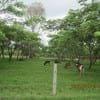





.jpg&w=3840&q=75)